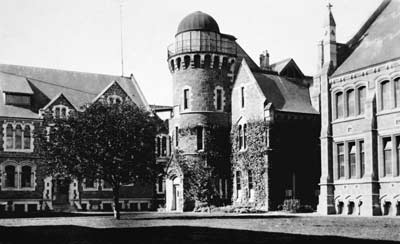The south quadrangle with the Physics Building visible behind the tree. The first official College tearoom was in the Physics Laboratory attic.

Tearooms
Canterbury College opened for business in 1873 without any buildings, and consequently there were no places for students to eat on campus. In the early years of the College a popular place for students taking a break was the coffee cart outside the BNZ in Cathedral Square, where you could buy coffee, saveloys and hot potatoes.
Once the campus started to evolve, various buildings included places for staff to retire to at tea time, while students had their common rooms where they could make tea and toast. The first official tearoom opened in 1921 in the attic of the Physics Laboratory. Here the limited menu included buns, biscuits, poached eggs on toast, pies and spaghetti on toast. The lack of space and a small stairwell meant that students had to queue for up to 10 minutes outside the tearoom until it opened. According to history lecturer Alice Candy, staff didn’t queue. They just arrived on time and pulled rank to get to the front.

The south quadrangle with the Physics Building visible behind the tree. The first official College tearoom was in the Physics Laboratory attic.

A design of the proposed layout for the Staff Common Room in the Students Union Building, from the Armson Collins Collection. The design is by Francis Petre.
Once the Student Union was completed in the 1930s, with its new refectory and common rooms, the lecture schedule was changed so that lectures would end at 10.50am and recommence and 11.10am. This ensured everyone had enough time to get to their common rooms for morning tea. The refectory became a place not just for refueling but also for entertainment. The College Review of 1946 notes that the Student Union tearooms were to be enlivened by exhibitions of artwork, organized by Rita Cooke (better known as Rita Angus), which “have created much interest in the work of the Art School.” Eventually the demands of the increasing numbers of students outstripped the capacity of the tearooms. In 1948 the Student Association complained that their tearooms could only hold 75 people at a time, and they had to serve in shifts to cater for about 480 customers per day. They concluded "Invaluable and beloved as our present building is, it is also beyond question, inadequate.”